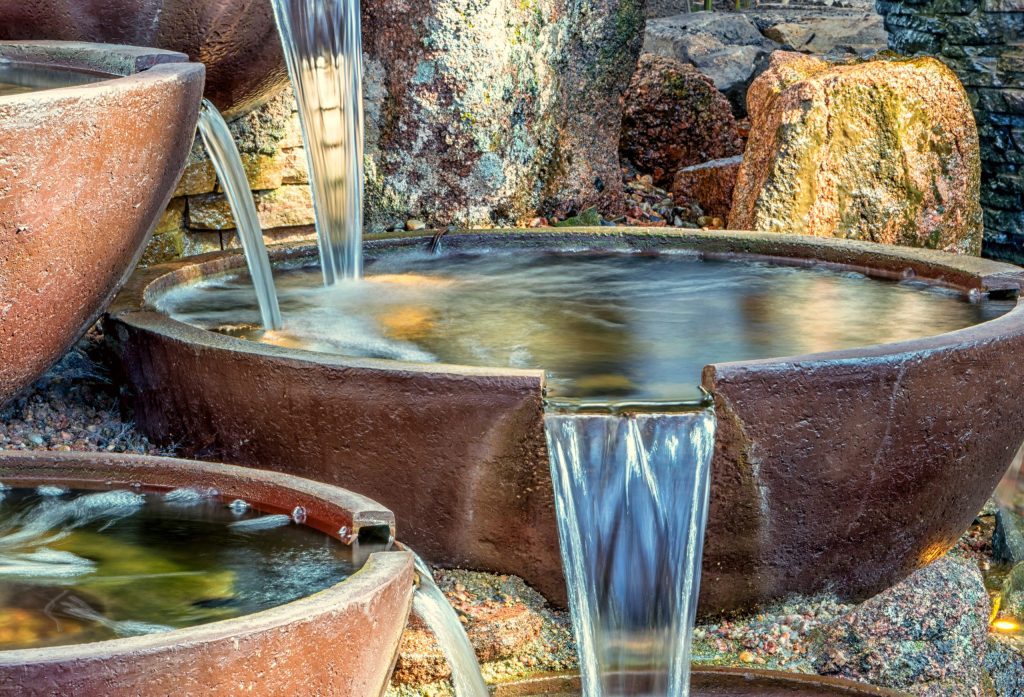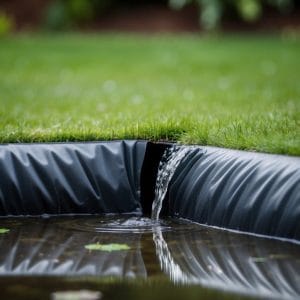
The Ultimate Guide to Creating a Serene Garden Oasis with a Pond and Water Feature
Create your very own tranquil garden retreat with the enchanting addition of a pond and water feature. Combining the soothing sounds of flowing water with the beauty of aquatic plants and graceful koi swimming lazily by, a pond and water feature can transform any outdoor space into a serene oasis.
In this ultimate guide, we will walk you through step-by-step instructions on how to design and build your own garden pond and water feature. From selecting the perfect location and choosing the right materials to creating a balanced ecosystem and incorporating stunning water plants, we’ve got you covered.
Discover how to create a harmonious blend of water, stone, and greenery that will not only enhance the aesthetic appeal of your garden but also provide a peaceful sanctuary for relaxation and meditation. Whether you have a small courtyard or a sprawling backyard, our guide offers practical tips and expert advice to help you bring your dream garden oasis to life.
Get ready to immerse yourself in the serene world of water gardening and create a haven of tranquility in your own backyard.
Benefits of having a pond and water feature in your garden
Creating a pond and water feature in your garden offers a multitude of benefits that extend beyond mere aesthetics. One of the most significant advantages is the calming effect that water has on the human psyche. The sound of gently flowing water can alleviate stress and anxiety, providing a soothing background that encourages relaxation and reflection. Whether it’s the soft trickle of a waterfall or the gentle lapping of pond water, these natural sounds can transform your outdoor space into a sanctuary where you can unwind after a long day.
Moreover, a pond serves as a habitat for various wildlife, including birds, frogs, and beneficial insects. This biodiversity not only enriches your garden’s ecosystem but also creates a lively environment that connects you to nature. Observing wildlife as they interact with the water can instill a sense of wonder and appreciation for the natural world. Additionally, the presence of water can attract other forms of life such as butterflies and dragonflies, adding to the beauty and vibrancy of your garden.
Another key benefit is the opportunity for gardening enthusiasts to explore aquatic plants and fish. A pond allows you to cultivate a variety of water lilies, lotus, and marginal plants, which can enhance the visual appeal of your garden while improving water quality. The introduction of koi or goldfish can also add an element of movement and color. Caring for these aquatic creatures can be a rewarding experience, fostering a deeper connection with your garden and its inhabitants. Overall, a pond and water feature not only beautify your outdoor space but also create a harmonious ecosystem that promotes relaxation, biodiversity, and engagement with nature.
Choosing the right location for your pond and water feature
Selecting the right location for your pond and water feature is crucial for both aesthetic appeal and functionality. Ideally, you want to choose a spot that receives a balance of sunlight and shade. Most aquatic plants thrive in sunlight, but too much direct sun can lead to excessive algae growth. A location that receives morning sun and afternoon shade is often ideal, allowing plants to photosynthesize without overheating. Additionally, consider the view from your home and outdoor seating areas; placing your pond where it can be easily seen and enjoyed will maximize its impact.
It’s also essential to evaluate the drainage and topography of your garden when determining the perfect site. Avoid areas prone to flooding, as this can disturb the pond’s ecosystem and make maintenance difficult. Instead, opt for a slightly elevated spot that allows for proper drainage while still being accessible for maintenance and cleaning. If your garden has slopes or uneven terrain, you may want to consider constructing a tiered pond to make the most of the landscape, creating visual interest and depth.
Lastly, think about the proximity to existing trees and shrubs. While some shade can be beneficial, too many leaves falling into the water can lead to increased debris and potential water quality issues. Moreover, tree roots can interfere with the pond’s structure if placed too close. Ideally, maintain a distance of at least 10 feet from large trees to minimize these concerns. By carefully considering these factors, you can choose a location that enhances the beauty and functionality of your garden pond and water feature.
Designing your garden around the pond and water feature
Once you have selected the perfect location for your pond and water feature, the next step is to design your garden around it. Start by envisioning the overall aesthetic you want to achieve. Consider the style of your home and existing landscaping; a modern home might benefit from a sleek, minimalist pond design, while a cottage-style garden could incorporate more naturalistic elements with curvy edges and rustic materials. Sketching out your design can help visualize how the pond will integrate into your overall garden layout.
Incorporating pathways around the pond is essential for accessibility and aesthetics. A meandering path can guide visitors around the water feature, allowing them to appreciate different viewpoints. Use natural materials such as stone, gravel, or wood to create a cohesive look that blends with the surrounding environment. Consider adding seating areas nearby, such as benches or chairs, to invite relaxation while enjoying the soothing ambiance of the water. This thoughtful design will create a welcoming atmosphere that encourages visitors to linger and appreciate the tranquility of your garden oasis.
Another important aspect of design is planning for plant placement around the pond. Use a combination of taller plants and smaller ground covers to create layers of texture and color. Additionally, consider using rocks or boulders strategically placed around the pond to enhance its natural appearance. These elements not only add visual interest but can also provide habitats for wildlife. By thoughtfully designing your garden around the pond and water feature, you can create a harmonious space that enhances both the beauty of your home and the serenity of your outdoor retreat.
Selecting the right plants for a garden oasis
Choosing the right plants for your pond and surrounding garden is crucial to creating a harmonious and balanced ecosystem. Start by selecting aquatic plants that thrive in your climate and the specific conditions of your pond. Water lilies and lotuses are popular choices for adding beauty and providing shade, while marginal plants like iris and cattails can help filter water and provide habitat for wildlife. Be sure to consider the growth habits of these plants, as some can spread rapidly and may need to be contained.
In addition to aquatic plants, consider incorporating a variety of native plants around the pond’s edge. Native plants are more adaptable to local conditions and provide essential habitat for local wildlife, including pollinators. Additionally, their deep root systems can help stabilize the soil and prevent erosion, which is particularly important for maintaining the integrity of your pond. Popular choices include ferns, sedges, and flowering perennials that can thrive in moist conditions.
Don’t forget about seasonal interest when selecting plants. Aim for a combination of evergreens, flowering plants, and grasses that provide visual interest throughout the year. This will ensure that your garden oasis remains vibrant and inviting, even in the colder months. By thoughtfully selecting a diverse range of plants, you can create a lush and inviting environment that enhances the beauty of your pond and water feature while supporting a healthy ecosystem.
Installing and maintaining your pond and water feature
The installation of your pond and water feature requires careful planning and execution to ensure its longevity and functionality. Begin by excavating the area according to your design, considering the depths required for various plants and any aquatic life you wish to introduce. It’s essential to create shelves at different levels within the pond for planting, which will help support the growth of marginal plants and provide visual layers. After excavation, lining the pond with a high-quality pond liner is crucial to prevent leaks and ensure a stable water environment.
Once the liner is in place, fill the pond with water and allow it to settle before introducing any plants or fish. This waiting period will help you check for any leaks and ensure the water chemistry is suitable for aquatic life. Adding beneficial bacteria at this stage can help establish a balanced ecosystem, which is vital for the pond’s health. When introducing plants, stagger their placement to create a natural look, and be mindful of their growth habits to avoid overcrowding.
Maintenance is an ongoing process that ensures your pond remains a serene oasis. Regularly check water levels, as evaporation can affect the pond’s balance, especially during hot weather. Additionally, monitoring water quality is essential; test for pH levels, ammonia, and nitrates to keep the environment healthy for fish and plants. Cleaning the pond, removing debris, and managing algae growth are also crucial tasks that can enhance the visual appeal and health of your water feature. By committing to regular maintenance, you can enjoy the tranquil beauty of your pond for years to come.
Enhancing the ambiance with lighting and accessories
To truly elevate the serenity of your garden oasis, consider incorporating lighting and accessories that enhance the ambiance of your pond and water feature. Submerged LED lights can create a magical effect at night, illuminating the water and highlighting the beauty of your aquatic plants and fish. Position lights strategically to cast gentle reflections and shadows, creating an enchanting atmosphere. Solar-powered lights offer an eco-friendly option that can be easily installed without the need for electrical outlets.
In addition to lighting, accessories such as decorative rocks, fountains, or sculptures can add layers of interest and personality to your pond area. A fountain not only adds a dynamic element with the sound of splashing water but also helps aerate the pond, promoting a healthy environment for aquatic life. Choose accessories that complement the overall design of your garden and resonate with your personal style, whether that be rustic, modern, or whimsical.
Lastly, consider creating seating areas with comfortable outdoor furniture where you can relax and enjoy your garden oasis. Cozy nooks with cushions and throws can encourage long moments of reflection, reading, or simply enjoying the sounds of nature. By thoughtfully adding lighting and accessories to your pond and garden, you can create an enchanting atmosphere that transforms your outdoor space into a peaceful retreat, day or night.
Attracting wildlife to your garden oasis
A well-designed pond and water feature can become a haven for wildlife, adding vibrancy and life to your garden oasis. To attract a diverse range of species, start by creating a natural habitat around the pond. Incorporate native plants, as they provide essential food and shelter for local wildlife. For example, flowering plants can attract pollinators like bees and butterflies, while dense vegetation offers protection for small mammals and birds. The more diverse your plant selection, the more wildlife you will invite to your garden.
Another effective way to attract wildlife is by providing additional water sources and habitats. Consider adding shallow areas to your pond where frogs can bask and lay eggs. Install rocks and logs around the pond to create perches for birds and resting spots for beneficial insects. These small features can significantly enhance the biodiversity of your garden. Additionally, placing bird feeders and baths nearby can increase the likelihood of attracting various bird species, enriching the overall ecosystem.
Lastly, practice sustainable gardening techniques to create a welcoming environment for wildlife. Avoid chemical pesticides and fertilizers, as these can harm beneficial insects and aquatic life. Instead, opt for organic alternatives and natural pest management strategies. By fostering a healthy, balanced ecosystem, your pond and water feature will not only serve as a tranquil escape for you but also as a thriving habitat for a variety of wildlife, creating a dynamic and engaging garden oasis.
Troubleshooting common pond and water feature issues
Even the most beautifully designed ponds can encounter issues over time, but many of these challenges can be effectively managed with proper care and attention. One common problem is algae growth, which can quickly turn a serene pond into a murky mess. To combat algae, maintain a balanced ecosystem by introducing aquatic plants that compete for nutrients. Regularly removing debris and excess nutrients from the water will also help. In cases of severe algae blooms, consider using barley straw or beneficial bacteria as natural treatments to restore balance.
Another frequent issue is water quality. Factors such as pH levels, ammonia, and nitrate concentrations can all impact the health of your pond and its inhabitants. Regular testing of water parameters is essential, especially in the early stages of establishing your pond. If you discover imbalances, perform partial water changes to dilute toxins and introduce beneficial bacteria to help establish a healthy environment. Keeping a close eye on water quality will ensure the well-being of fish and plants alike.
Finally, be vigilant about the presence of pests or diseases that can affect your aquatic life. Common problems include parasites or infections in fish, which can often be managed through quarantine measures and proper treatment. Regularly observing your fish for any signs of distress or unusual behavior can help you catch problems early. By being proactive and addressing issues as they arise, you can maintain a healthy and beautiful pond that continues to serve as a tranquil oasis in your garden.
Conclusion and final thoughts
Creating a serene garden oasis with a pond and water feature is a rewarding endeavor that offers numerous benefits, from enhancing the beauty of your outdoor space to providing a peaceful environment for relaxation. By carefully selecting the right location, designing your garden thoughtfully, and choosing appropriate plants, you can create a harmonious ecosystem that attracts wildlife and supports biodiversity. Regular maintenance and attention to detail will ensure that your pond remains a vibrant and healthy part of your garden.
Incorporating lighting and accessories can further elevate the ambiance, allowing you to enjoy the tranquility of your garden at any time of day. As you embark on this journey, remember that patience and observation are key. Your pond will evolve over time, becoming a unique reflection of your efforts and the natural world around you.
Ultimately, your garden oasis will serve as a sanctuary not only for you but also for the myriad of creatures that call it home. Embrace the beauty and serenity of water gardening, and let your pond become a cherished retreat where you can connect with nature and find solace in the soothing sounds of water. With careful planning, creativity, and dedication, you can bring your dream garden oasis to life.



